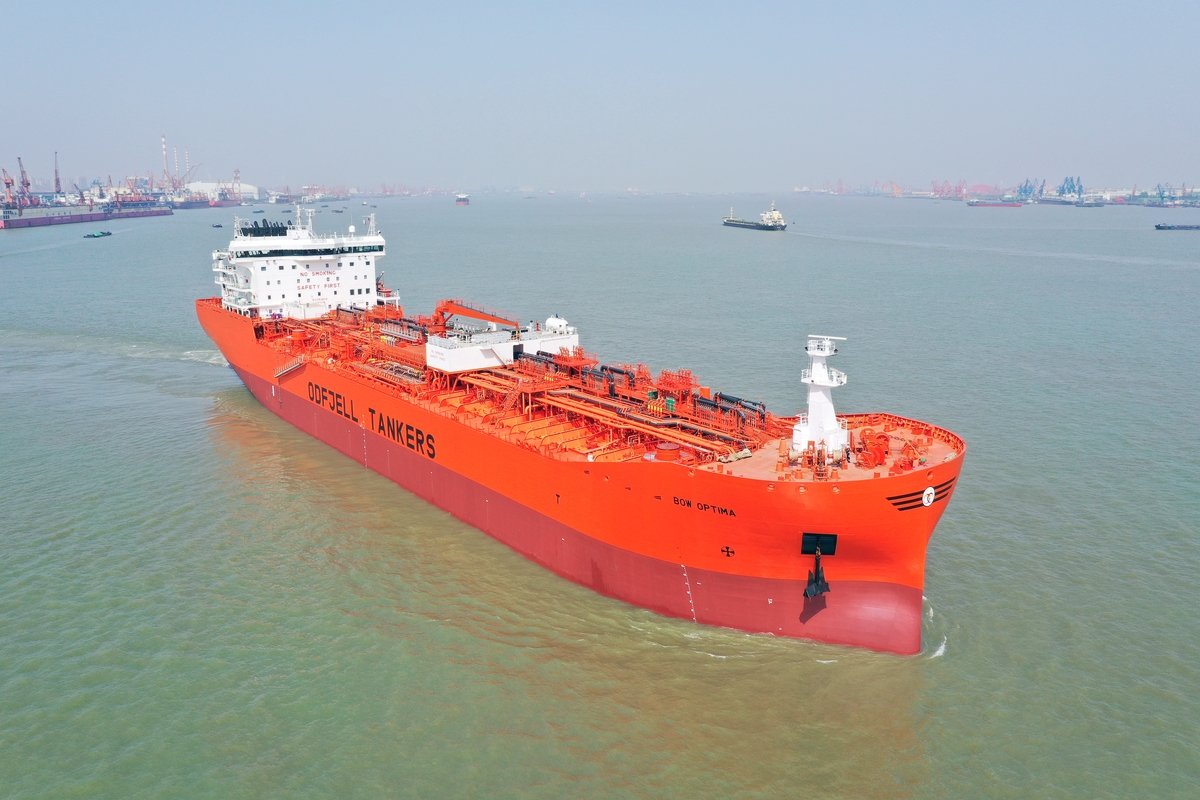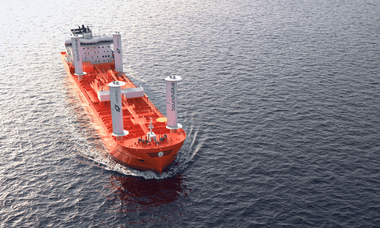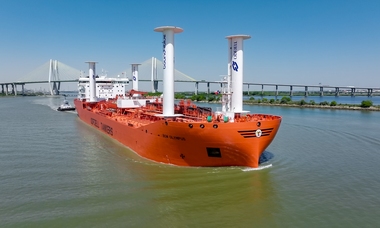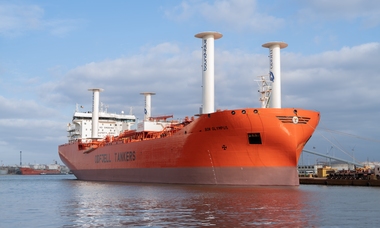The below is a translated version of an article published in the Norwegian
maritime daily Kystens Næringsliv on August 28, 2025. Written by Arvid Steen.
Odfjell SE is doubling the number of sail-equipped vessels from two to four after the success with Bow Olympus. The shipping company has astonished Japanese shipbuilders and competitors around the world.
“Sails on a chemical tanker really shouldn’t have been possible,” says CEO Harald Fotland.
Twenty chemical tankers bearing the Odfjell logo are now under construction in Japan. This is the Bergen company’s largest newbuilding program since the 1990s.
Initially, two of them were to have sails installed.
One was the five-year-old Bow Optima. Bow Olympus is already sailing the seven seas with sails. But now CEO Harald Fotland tells Kystens Næringsliv that the company has decided to double that number.
Two additional Japan-built ships will get sails.
About Odfjell’s sails
Odfjell partnered with Bound4Blue to install eSAIL technology on the chemical tanker Bow Olympus in March 2025. The suction sail—an advanced wind-propulsion system—combines traditional sailing principles with modern aerodynamics to maximize thrust and efficiency.
A fan at the top of the sail controls the airflow, and the sail’s porous surface channels air upward, ensuring smooth airflow and maximum thrust. It can be compared to an aircraft wing that creates lift.
The technology produces up to seven times more thrust per unit area than conventional sails, significantly reducing fuel consumption and CO₂ emissions. This enables more efficient and environmentally friendly voyages.
Visually, it looks more like a giant cylinder than the traditional sails most people have seen.
“The Japanese shipbuilders are not very familiar with sail technology, so the process takes as long as necessary. It’s not often that the biggest yards in Japan build chemical tankers with sails. There are hardly any in the world yet. But we’ve decided to expand the portfolio to four ships,” Odfjell CEO Harald Fotland tells Kystens Næringsliv.
Enormous attention
Fotland says he can’t remember the last time Odfjell received so much positive attention for something as “traditional” as sail technology.
The CEO says that, overall, the company saves larger sums on new, eco-friendly and propulsion-efficient propellers, gearing systems, new water-treatment systems, and new types of hull lubrication that reduce friction below the waterline.
“But that’s a bit boring to hear about, isn’t it?” Fotland says with a smile. He adds:
“Sails are a bit more fun. We’ve never received as much positive attention from shareholders, the media, and other shipping companies as we’re getting now. At the same time, there’s a strategic rationale behind sails that has been in the works for years. We’re also getting inquiries from around the world from shipping companies curious about the suction-sail technology,” says Harald Fotland to Kystens Næringsliv.
But as is well known, the company doesn’t live on attention.
Saving money and the environment
This is why the company found it reassuring that the first voyage from Houston across the Atlantic demonstrated real fuel reductions.
The company has calculated that they could end up saving 10 percent in fuel annually—per ship.
“For the first time in Odfjell’s history, we combined sails with 100 percent biofuel. As a result, the crossing was virtually emissions-free, as we achieved an 85 percent reduction in greenhouse gas intensity (GHG). In plain terms, that largely means we avoid having to pay to the EU emissions trading system, since we came well below the thresholds where it kicks in,” VP Technology Erik Hjortland told Kystens Næringsliv this spring.
In addition, energy efficiency improves by 15–20 percent with the use of sails.
The company is investing close to half a billion in sailing know-how
The company’s figures are below the EU’s 2050 requirements and meet IMO requirements at least through 2044.
“In other words, Odfjell has already met environmental requirements that will be introduced 20–25 years from now,” the company’s technology VP pointed out.
Which in turn means reduced environmental expenses—or, to put it simply, less tax to the EU.
Shouldn’t be possible
Setting aside the environmental perspective, better working conditions, and a more positive and challenging everyday life for the seafarers who get to test new technology—and the savings in hard cash for the company—Fotland also emphasizes that this sail technology really shouldn’t have been possible on a chemical tanker.

“When we started with the idea of sails on chemical tankers, there were certainly voices saying we wouldn’t manage it. On our decks there’s a ‘spaghetti world’ of pipes that you can hardly move and that preferably shouldn’t get damaged. Getting four sail foundations (or masts, to put it simply) in place has been an engineering feat that I’m impressed by.”
CEO Harald Fotland
He adds that he hopes more shipping companies will follow.
As president of the Norwegian Shipowners’ Association, he sees that curiosity about sails has begun to truly awaken.
“We’ll see. Many of our colleagues in Norwegian shipping will probably go through the ‘boring’ part of the toolbox first—changing propellers, propulsion systems, hull lubrication, and maybe a water-treatment system or two—before they set sail as well,” says Fotland.
Before adding: “I have to say I’m very impressed by Norway’s Seatrans. They’ve come a long way too.”



